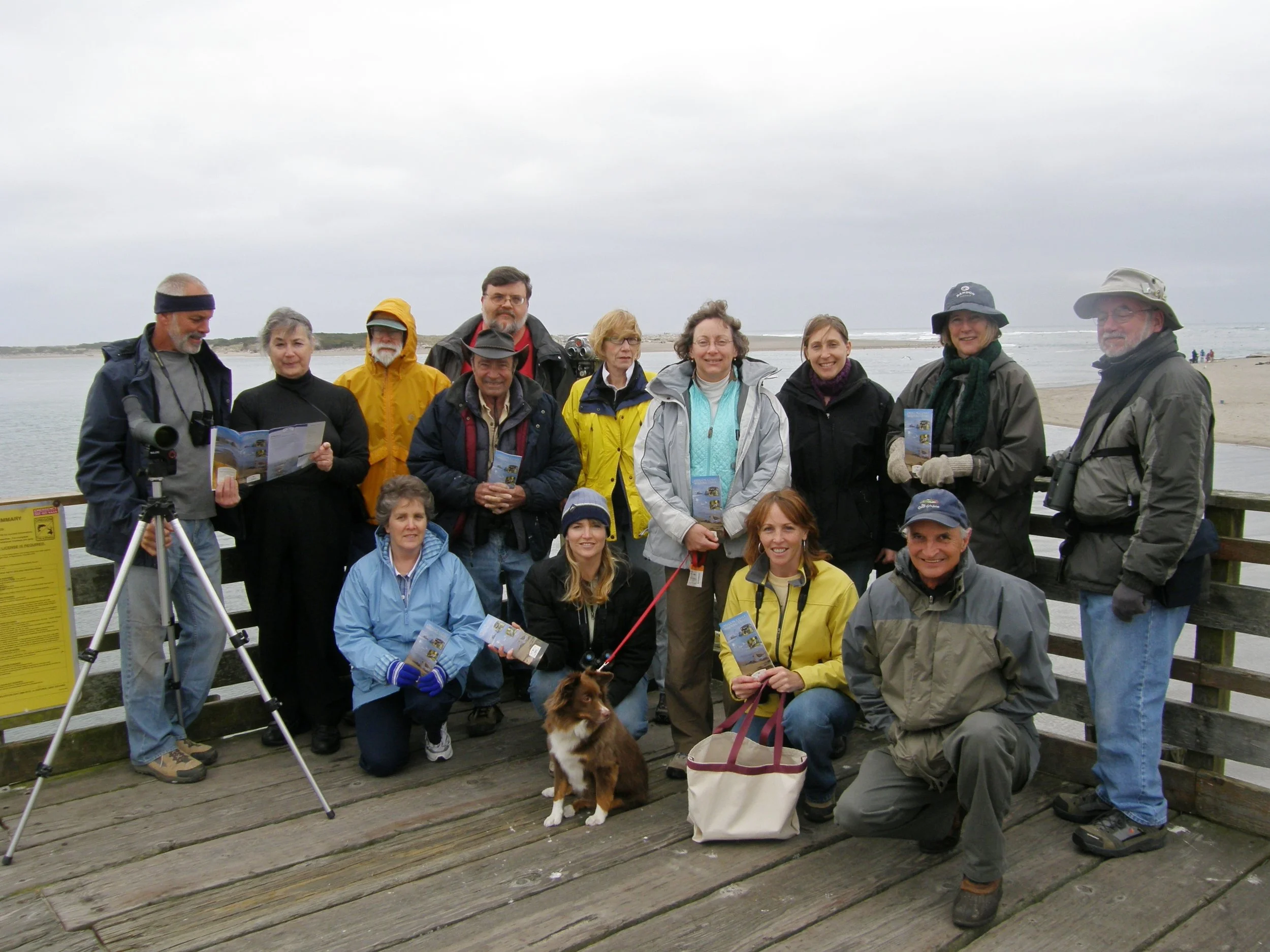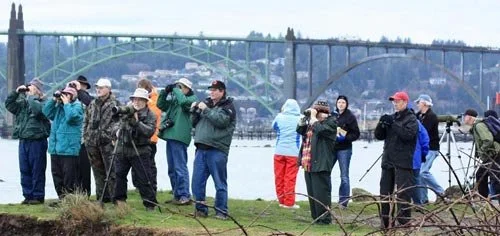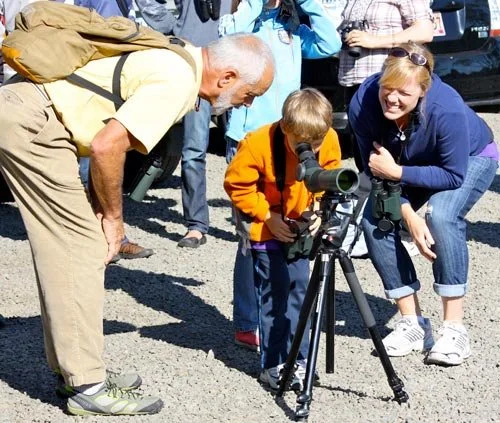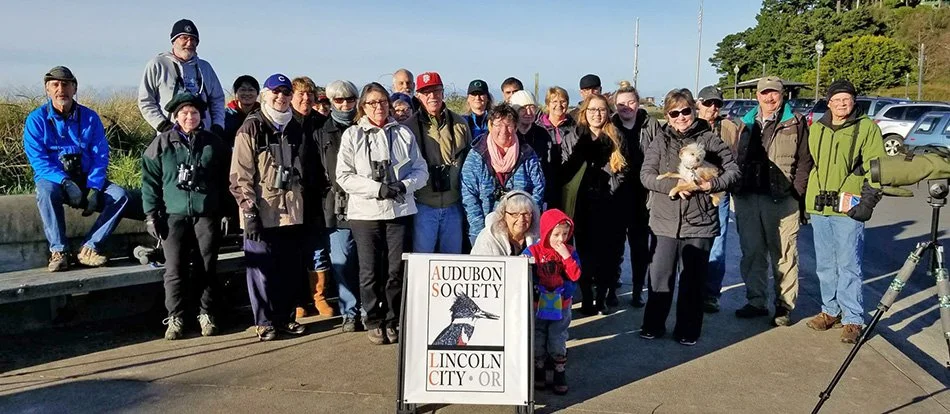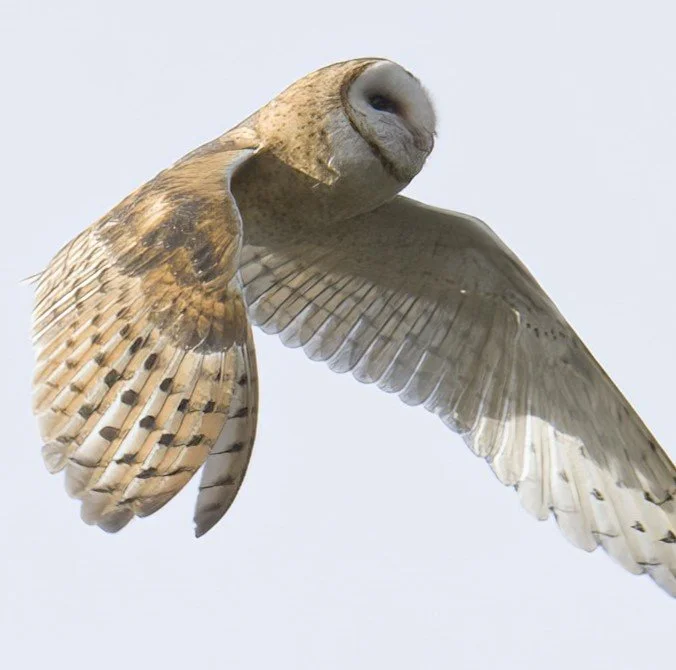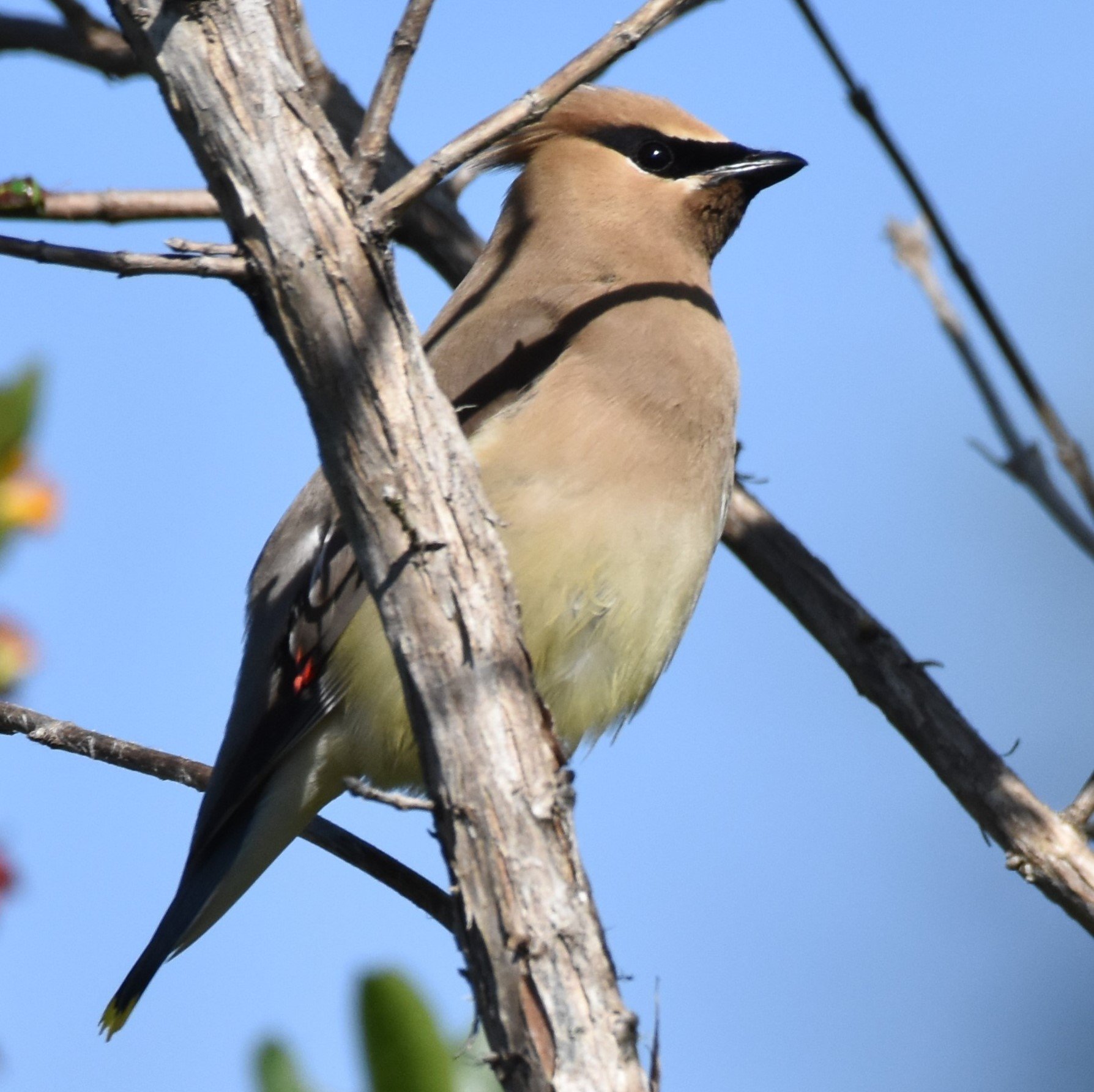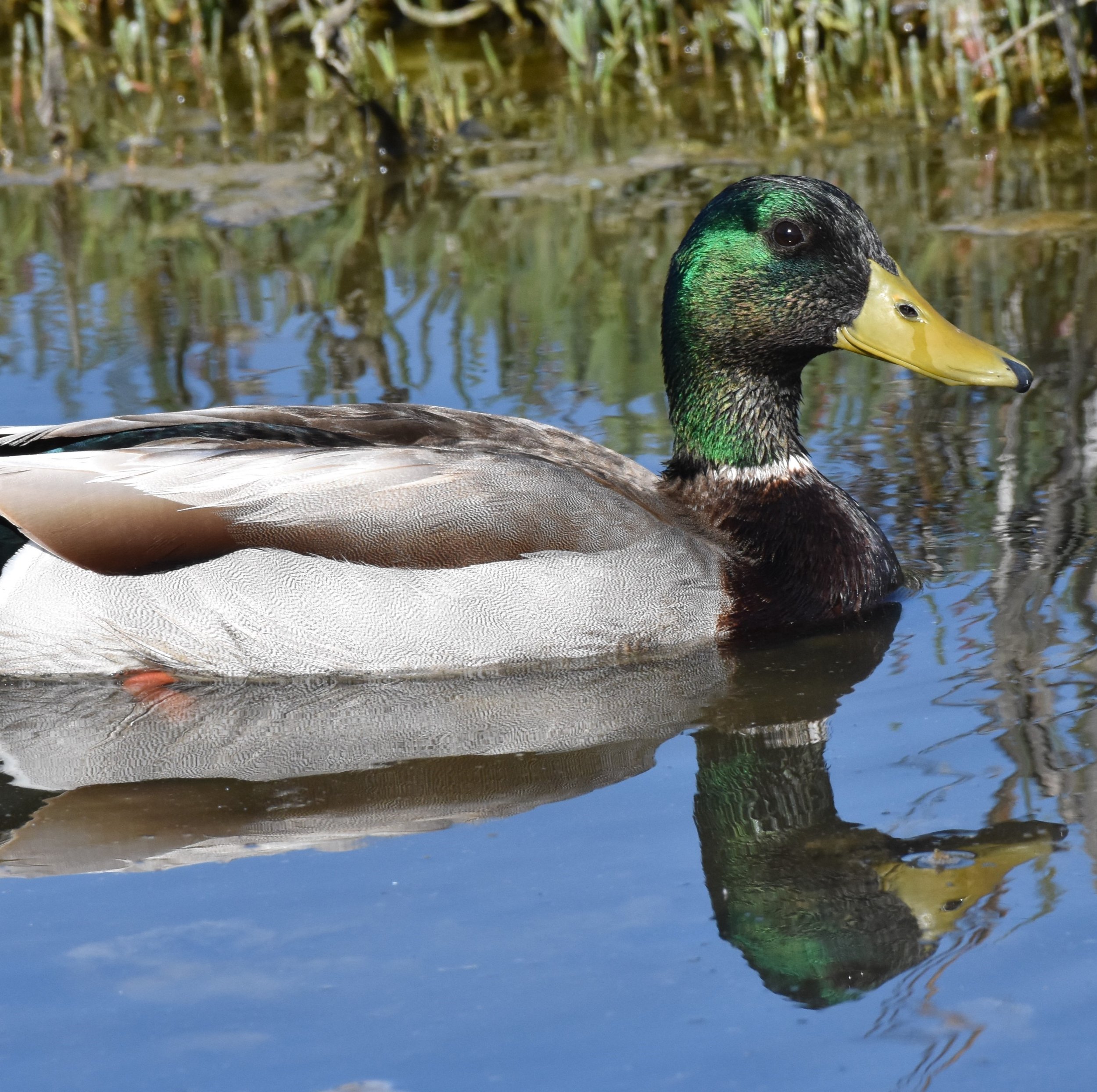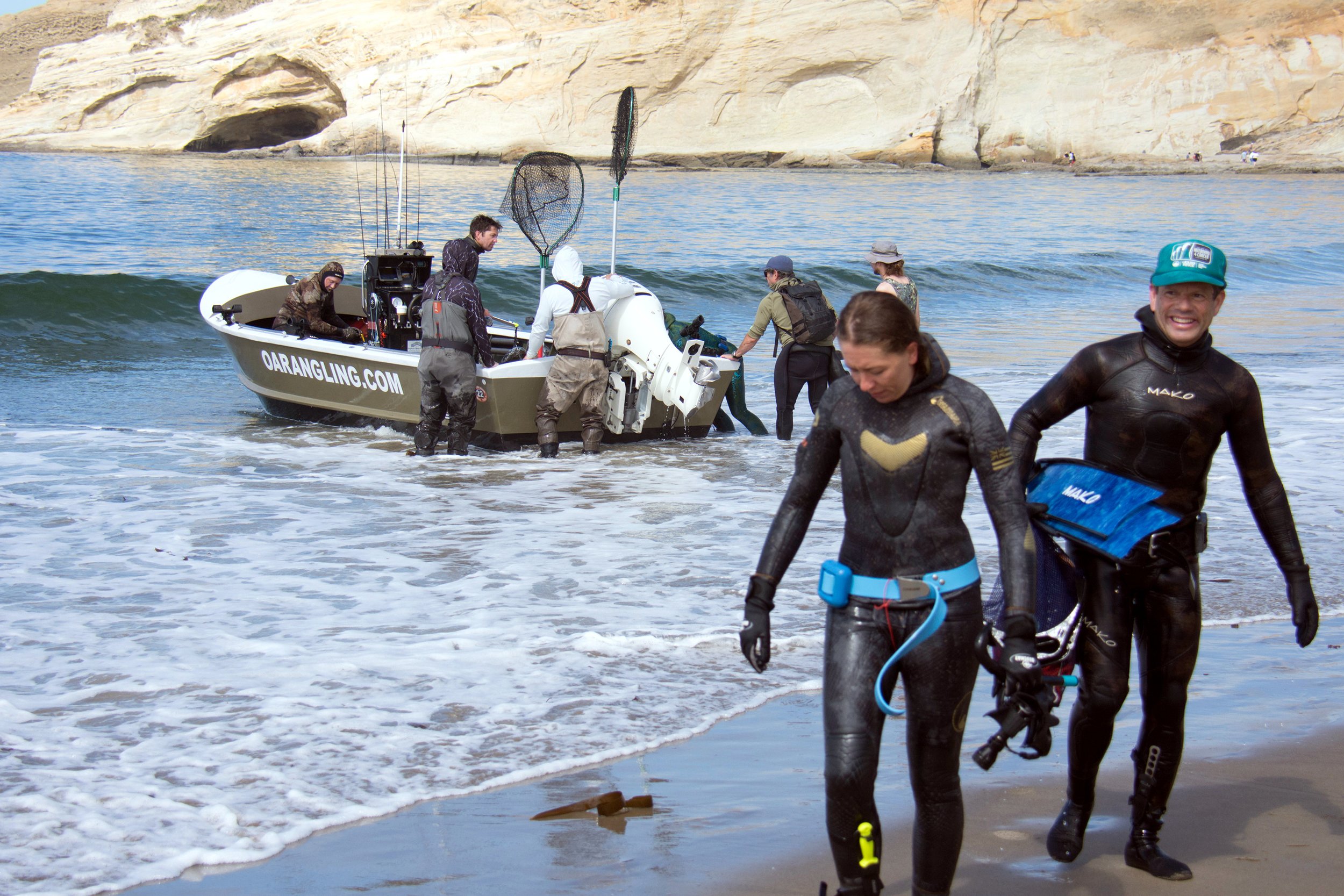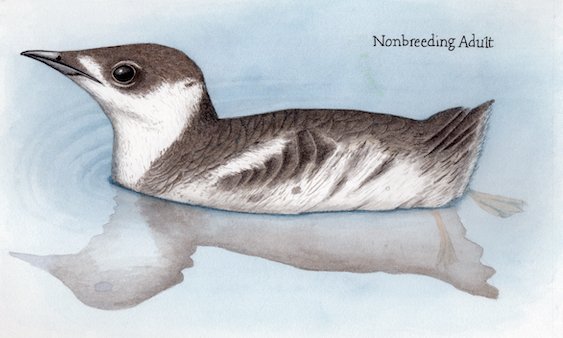Looking Back at 20 Years of Seven Capes
This year, 2025, marks the 20th anniversary of Seven Capes Bird Alliance, Oregon’s youngest Audubon chapter. We are incredibly proud of all that we’ve accomplished over the last two decades while staying true to our roots as a dedicated group of birders who care deeply for the land we call home. As we prepare for our 20th anniversary celebration, we’ve reflected on our history and what’s changed–and what’s stayed the same.
In 2005, a small group of volunteers founded Oregon’s first new Audubon chapter in 22 years, outlining our mission and focus areas of education, conservation, and community science. In the following summer of 2006, this mission and commitment to our focus areas were highlighted in the first edition of our newsletter, The Kingfisher, which our members still enjoy biannually. As a fledgling organization, the best way to foster community interest in birding and wildlife was obvious–get folks outside. Our monthly bird walks, a pillar of our programs that continues to be a touchstone for community engagement, began that same year.
Our first in-school education program began in 2008 when we introduced “Audubon Adventures” to classrooms at Oceanlake and Taft elementary schools. We stretched further into our service area and expanded our education efforts to classrooms in Tillamook, Newport, Toledo, and Siletz in 2011 and began our first adult education program at Oregon Coast Community College in 2012.
From the beginning, our education volunteers have been a driving force behind our outreach and community-building capacity. With their dedication, we continue to explore new ways to collaborate with educators in Lincoln and Tillamook counties. In 2025, we’ve had the chance to pilot new programs in Tillamook and are looking forward to announcing upcoming new educational opportunities in south Lincoln County. After all, building an appreciation for the natural world is the first step in creating the desire to protect it!
Where education plants the seed for understanding wildlife and their habitats, community science offers the opportunity to get directly involved. In 2013, we participated in National Audubon’s Christmas Bird Count for the first time, and we took part in our first Great Backyard Bird Count in 2014. Both counts have become an annual tradition for volunteers to participate in community science.
We’ve even developed our very own community science project inspired by our 2019 “Our Neighbor the Osprey” education program and members’ informal observation of local Osprey nests. In 2023, we formalized these observations by launching our Osprey Watch program as part of our Osprey Awareness Initiative. Now, for three seasons, enthusiastic volunteers have tracked local nests as part of a greater effort to bring attention to the Ospreys that grace our communities every summer. This July, we launched our first annual Lincoln City Osprey Day!
At the heart of our programs is the drive to foster community care for the wildlife and habitats that surround us. From our founding, conservation advocacy has been a key component of the organization, and in 2017 and 2018, the Board of Directors decided to begin prioritizing these efforts with unprecedented energy. In 2020, we took on our greatest conservation challenge so far by proposing Marine Conservation Areas at Cape Lookout and Cape Foulweather Complex. Three years and many meetings later, the Department of Land Conservation and Development approved these proposals in 2023, solidifying our reputation for leadership, effectiveness, and collaboration.
The growth that we have seen over the last 20 years has required and produced significant changes: we are now supported by four staff members, increased membership, and major grant funding. Our name has changed to better reflect our service area and values, and our efforts are more evenly distributed across our priority areas. Even so, we remain a volunteer-led organization that relies on our membership dues. We are still Oregon’s youngest Audubon chapter, and our commitment to the National Audubon Society remains. For us, this exercise in reflection has revealed that our founding mission is stronger than ever: to encourage residents and visitors to protect and enjoy the native birds, other wildlife, and habitats found on Oregon’s coast through conservation, education, and community science!
With many thanks to our volunteers, members, and donors, we look forward to the next decade of working together for birds and nature.
Celebrate Lincoln City Osprey Day!
Join us for our inaugural celebration of Lincoln City Osprey Day on Friday, July 11, 2025! In 2023, with the help of grants from National Audubon Society and Oregon Birding Alliance, we began our Osprey Awareness Initiative with the goal of filling the gaps in knowledge about Ospreys in our area and increasing understanding and appreciation for these magnificent raptors. With two rivers, a lake, and the Pacific Ocean, Lincoln City provides local breeding Ospreys with plenty of fishing opportunities, making it the perfect place to return year after year to raise young.
This year, we’re excited to start a new annual tradition of celebrating Lincoln City Osprey Day! Join us on Friday, July 11, for opportunities to learn about our local Ospreys, observe their nests, and enjoy art and live performances in honor of our Oregon State Raptor!
What to expect:
Bird Walk at Nesika City Park, 9-11 a.m.
Visit the nesting Osprey pair and look for songbirds in the woods and wetlands!
Meet at SE 3rd and Mast.
Osprey Nest Observations, 10 a.m.-Noon
Volunteers from our Osprey Watch team will be observing some of our Lincoln City nests with scopes (look for our Osprey Day flags!). Check back for a list of nest locations after July 1.
Osprey Day Activities, 11:30 a.m.-4 p.m. at Lincoln City Cultural Center
Live raptor presentation, My Life as an Osprey family story time, musical performance by Your Song, My Song, and more fun for the whole family!
(540 NE Hwy 101, Lincoln City, OR)
Lincoln City Osprey Day is supported by our generous sponsors: Explore Lincoln City, Ernie Rose, Roundhouse Foundation, Lincoln City Parks & Recreation, and individuals who have contributed to our Osprey Day matching fund.
Come work with us as our Volunteer Coordinator!
We’re pleased to announce an opportunity to work with us here at Seven Capes Bird Alliance! Love birds and people? This job could be for you–apply now!
We’re pleased to announce an opportunity to work with us here at Seven Capes Bird Alliance! We’re looking for a new Volunteer Coordinator who will be responsible for developing, implementing, and leading a volunteer program for our Coastal Habitat Campaign, which includes stewardship programs at our recently designated Marine Conservation Areas. If you love the coast, coastal birds, and people, we’d love to hear from you!
The Volunteer Coordinator is responsible for developing, implementing, and leading a volunteer program for our Coastal Habitat Campaign (CHC), which includes stewardship programs at our newly designated Marine Conservation Areas at Cape Foulweather, Fogarty Creek, and Cape Lookout. Tasks include, but are not limited to, working with and engaging individuals, coastal conservation groups, and businesses that are interested in participating in our CHC efforts and other initiatives requiring volunteers. The coordinator will recruit and train volunteers, track volunteer hours, and provide volunteer support.
Applications for the Volunteer Coordinator are open now! Learn more about the position and how to apply:
Snowy Plover Education in Tillamook County Classrooms
This spring, rural classrooms in Tillamook County learned all about Snowy Plovers, a threatened shorebird species that spends the breeding season on many Oregon beaches. While Snowy Plovers are federally listed as threatened, they are making a comeback…
This spring, rural classrooms in Tillamook County learned all about Snowy Plovers, a threatened shorebird species that spends the breeding season on many Oregon beaches. While Snowy Plovers are federally listed as threatened, they are making a comeback on the Oregon Coast thanks to effective management tactics as well as public education efforts. Through a grant provided by the Oregon Conservation and Recreation Fund, our education volunteers participated as part of a team under the leadership of Bird Alliance of Oregon to help raise awareness of the adorable little birds in five classrooms.
These tiny shorebirds nest on the dry sand portion of the beach, making them highly susceptible to nest failure. As more and more human activities take place on the beach, we have crowded out Snowy Plovers, causing a massive dip in population. Our project included making artwork for Oregon Parks and Recreation Department signage to be used near nesting sites.
Approximately 80 sixth graders at Nestucca K-8 and Neah-Kah-Nie Middle School made artwork illustrating best practices around Snowy Plover nesting areas, which include staying out of roped-off areas, picking up trash, keeping dogs leashed, and not flying kites or drones. The students were led by a team of artists and educators including our own science illustrator, Nora Sherwood. The students participated in a field trip on April 11 to Cape Lookout State Park to check out local shorebirds and the signs that are now deployed near active nests at Sitka Sedge and Bayocean.
Support Lincoln City’s Newest Park by Purchasing a Bird Brick!
We are collaborating with Lincoln City Parks & Recreation to bring you an opportunity to contribute to Lincoln City’s newest public park, Schooner Creek Discovery Park!
We are collaborating with Lincoln City Parks & Recreation to bring you an opportunity to contribute to Lincoln City’s newest public park, Schooner Creek Discovery Park! The new park is located in the Taft district of Lincoln City and will feature an inclusive and accessible playground, sports recreation areas, and gathering spaces for all to enjoy. As enthusiasts for all things outdoors, we are excited to support a new way to get outside in Lincoln City, and we invite you to join in the fun!
Through Lincoln City Parks & Recreation, you can now purchase a paver brick to be installed in the park. For our bird-lovers, we offer you the chance to shout out your favorite local bird on your brick! Once they’re installed, we will use the bird bricks as a tool to facilitate learning opportunities about the birds you can see at the park and surrounding areas. If you’d like to support Schooner Creek Discovery Park by purchasing a bird brick, here’s what you need to do:
Check our list of local birds to choose yours (note: shaded bird species are already taken).
Send us a message at info@sevencapes.org to let us know which bird (or birds) you chose!
Head over to Lincoln City Parks & Recreation’s donation page to purchase your brick and choose the 4x8 paver. For your inscription, type in your bird species in line one and your name in line two. If you prefer to stay anonymous, you can use both lines for your bird species (ex. line one: Black line 2: Oystercatcher) or feel free to use “Seven Capes” in line two. Complete your purchase.
We can’t wait to see the bird bricks at Schooner Creek Discovery Park! This is our latest effort to infuse the fun of birding into public spaces. We provided source photos for Joanne Daschel's beautiful bird mosaics in the new park's playground and are working with Lincoln City Parks and Recreation to install an Osprey nesting platform by Schooner Creek. To learn more about the park, click here. If you decide to buy a bird brick, we thank you for helping improve outdoor accessibility and inclusivity in our community!






Photos provided by Lincoln City Parks & Recreation and Ruth Shelly.
Join the Christmas Bird Count! Add your sightings to a 125-year tradition
In December, Seven Capes Bird Alliance is participating in National Audubon Society’s Christmas Bird Count (CBC). For 125 years, bird enthusiasts nationwide have participated in the world's longest-running wildlife census to provide information that helps scientists protect birds and the places they need.
If you love bird watching in this rich coastal habitat, please join us! All experience levels are welcome. You can either join a team of field counters or, if you live within one of the count circles, you can count from your backyard! Either way, you need to preregister. Field counters should dress for Oregon coastal weather with mud boots or sturdy shoes. Bring your own optical equipment, lunch or snack, and plenty of water. If that sounds too strenuous, or you don't have the full day to spend, check out the maps to see if you live within a count circle to participate as a backyard/feeder counter—we’ll send you a checklist.
Teams are organizing in our region for the following days:
December 14—Tillamook Bay. Contact Allison Anholt at Allison.anholt@gmail.com to register.
December 19—Lincoln City. Contact SCBA at info@sevencapes.org to register.
December 28—Yaquina Bay. Contact kaifrueh2@gmail.com by 12/23 for form and questions.
Begun in 1900 as an alternative to traditional Christmas Day bird hunts, hundreds of Christmas Bird Counts are now conducted throughout the Western Hemisphere. The CBC continues to contribute valuable scientific data to the longest existing record of bird population trends. This year, data will be sent to the Laboratory of Ornithology at Cornell University where over the years CBC records have been used to study changes in bird populations and wintering ranges. In 2023, a record high number of participants recorded more than 2,300 bird species across North and South America, and Pacific and Caribbean islands.
The Christmas Bird Count is free, fun, and makes a difference! See sevencapes.org/christmas-bird-count for maps of the Count Circles and registration information.
Announcing Our New Name: Seven Capes Bird Alliance!
At our annual member meeting on September 12, Board President dawn villaescusa revealed Seven Capes Bird Alliance as the new name of the former Audubon Society of Lincoln City.
“Our chapter began considering a new name two years ago,” dawn explained, “because Lincoln City didn’t reflect our service area of Lincoln and Tillamook Counties. Shortly thereafter, other Audubon chapters began to drop Audubon from their name, because John James Audubon held white supremacist views and desecrated Native graves. We agreed that Audubon in our name did not align with our chapter’s values and could be a barrier to participation in our activities.”
Our organization was founded in 2005 and remains a chapter of the National Audubon Society and a collaborative partner of the other eleven Audubon chapters throughout Oregon. “Bird Alliance” has been adopted by Portland’s chapter—now Bird Alliance of Oregon—along with many other chapters throughout the nation.
The new name defines our service area as the Oregon coast from Cape Perpetua in the south to Arch Cape in the north, with five capes (Foulweather, Kiwanda, Lookout, Meares, and Falcon) in between. These capes are beautiful and distinctive, provide essential habitat for birds and other wildlife, and remain a focus for the chapter’s conservation initiatives.
Before the Board voted on its new name, we surveyed our members and conservation partners multiple times and consulted the other Oregon chapters. Seven Capes Bird Alliance’s new logo, designed by Drift Awake Studios in Gearhart, Oregon, features a stylized view of sunset on the Oregon coast with capes receding in the distance and seven birds flying overhead.
Frequently asked questions about the name change can be found here. “While our name has changed, our mission remains the same,” dawn confirmed, “to encourage residents and visitors to protect and enjoy the native birds, other wildlife, and habitats on the Oregon coast through education, conservation, and community science. We’re still working together for birds and nature, but now with a new name that is more welcoming and inclusive.”
Photos by Ruth Shelly
Spend some time in the Cascade Head Experimental Forest
“In 1935 a study was initiated in (then 83)-year-old, even-aged stands of Sitka spruce (Picea sitchensis) and western hemlock (Tsuga heterophylla) at Cascade Head Experimental Forest in the Siuslaw National Forest on the Oregon coast that traced their development for 33 years.
“Permanent growth plots of Sitka spruce and western hemlock are located in the Cascade Head Experimental Forest, Siuslaw National Forest, near Otis on the Oregon coast. The (now nearly 180)-year-old forest supports a well-stocked stand of Sitka spruce and western hemlock, believed to have become established after the 350,000-acre Nestucca fire in 1845.”
From: Growth and Yield of Sitka Spruce and Western Hemlock at Cascade Head Experimental Forest, Oregon
Stephen H. Smith, John F. Bell, Francis R. Herman, and Thomas See (1984 Research Paper).
___________________________________________________________
Steve Griffiths and Joseph Youren, Audubon Society of Lincoln City board members, spent a morning in late May 2024 checking on forest conditions in this area just north of Otis, Oregon. The Cascade Head Experimental Forest (CHEF) provides great examples of an old, mature, structured temperate rainforest landscape. It includes massive, towering examples of Douglas fir, western hemlock, and the iconic Sitka spruce.
This area is a great example of how federal forest management and operations can restore and improve forest conditions. It's a short drive on a paved road just north of Lincoln City and provides excellent views of not only structured and mature but also OLD forest (over 170 years). We highly encourage a visit.
These photos record a healthy western hemlock understory, large snags and downed wood, with lots of horizontal and vertical heterogeneity—all coming together to provide a near-perfect example of an older forest.
The CHEF is filled with towering giants—the western hemlock on the left in the photo below measured 112 inches around at breast height, the Douglas fir 114 inches.
This massive Sitka spruce, below, measured 14 feet, 10 inches around (4.7 feet wide) at breast height.
But the real gem of the field trip was this giant Sitka just 2 inches shy of 18 feet in circumference above massive buttressing roots.
A stand marked for thinning—no date is available for when this operation occurred.
Immediately adjacent to the thinned stand above is an un-thinned stand lacking the characteristics of a healthy maturing stand.
Photos provided by Joseph Youren
We're hiring a volunteer coordinator!
We’re pleased to announce that we have a new opportunity to work with us here at ASLC!
We’re pleased to announce that we have a new opportunity to work with us here at ASLC! We’re looking for a new Volunteer Coordinator who will be responsible for developing, implementing, and leading a volunteer program for our Coastal Habitat Campaign, which includes stewardship programs at our newly designated Marine Conservation Areas. If you love the coast, coastal birds, and people, we’d love to hear from you!
This is a part-time, seasonal position running approximately mid-April through mid-September. Would you or someone you know be interested in supporting our Coastal Habitat Campaign as our Volunteer Coordinator? Click the link below to learn more about the position and see how to apply!
Christmas Bird Count 2023
All skill levels and ages are welcome! Join the world’s longest running citizen science survey and count birds from sunup to sundown.
All skill levels and ages are welcome! Join the world’s longest running citizen science survey and count birds from sunup to sundown. The annual Christmas Bird Count provides critical data on avian population trends that scientists around the world use to guide conservation efforts.
Want to help? We’re have three count circles in our area! All counts are FREE, but registration is required. Learn how to register for a count circle near you:
Learn more about the history and impact of the Christmas Bird Count and see our FAQ here!
Search for "Bird Bricks" at Lincoln City Cultural Plaza
We invite you to join us for a new kind of bird walk!
After several years of fundraising and months of construction work, the new Cultural Plaza at the Lincoln City Cultural Center is ready to open to the public! As part of a fundraising and outreach effort, ASLC collaborated with the Center to install 47 donated “bird bricks” with bird names throughout the plaza. Each brick was generously donated by our supporters and fellow bird lovers.
We invite you to join us for a new kind of bird walk! See the “field guide” and bird gallery below and search for each bird brick as you walk through the plaza. Download and print the field guide to take with you and click through the gallery to see expanded images of the birds.
The Lincoln City Cultural Center is hosting a Plaza Activation Party on Saturday, November 18, 2023. Our representatives will be there to hand out the field guides, and we’d love for you to join us! Learn more about the event here.
"Reserve Inspiration" Art Exhibit Opens July 7
Coos Art Museum features the Oregon Marine Reserves!
Audubon Society of Lincoln City opens its acclaimed exhibition Reserve Inspiration at the Coos Art Museum on July 7, running through September 22. Reserve Inspiration features five coastal artists who share work inspired by the beauty and diversity of Oregon's Marine Reserves in media ranging from painting and scientific illustration to ceramics, collage, and even FirePainting. The opening reception is Friday, July 14, from 5-7 p.m.
Reserve Inspiration presents how the nature of the Reserves inspires artists who explore the following themes in various media:
Diversity. In nature as in society, diverse systems are strong systems. Marine reserves ensure protection of diverse species which may not otherwise survive.
Change Over Time. Marine reserves differ from each other and offer an opportunity to study systems over decades to detect both sudden and subtle changes, which reveal the health of the ecosystem and our planet.
Patience. Like any investment, maintaining and researching a marine reserve require a long-term commitment over generations to observe change in natural cycles.
Interconnectedness. Plants, animals, and people are interconnected in marine reserves in ways known and yet to be discovered. Strengthening, not severing, those connections is key not only within the reserve, but also in our human relationship to the natural world.
The exhibition features five artists of varying media and style:
Julie Fiedler is a ceramics artist and painter and directs St. James Santiago School in
Lincoln City.
Cynthia Longhat-Adams is a self-taught multimedia artist who uses pyrographic
methods, or FirePainting, in an ever-evolving process that powers her growth as an
artist.
Victoria McOmie lives on the central Oregon Coast and is a painter and mixed media
artist taking creative cues from nature for over four decades.
Nora Sherwood holds a certificate in natural science illustration from the University of
Washington and works for clients in Oregon and beyond.
Jill Perry Townsend paints plein air in oils; she loves the ocean and landscape of the
coast and the adventure of going out into amazing places to paint.
Coos Art Museum is located at 235 Anderson Ave, Coos Bay, Oregon; check website at https://www.coosart.org/ or call (541) 267-3901 for admission and hours.

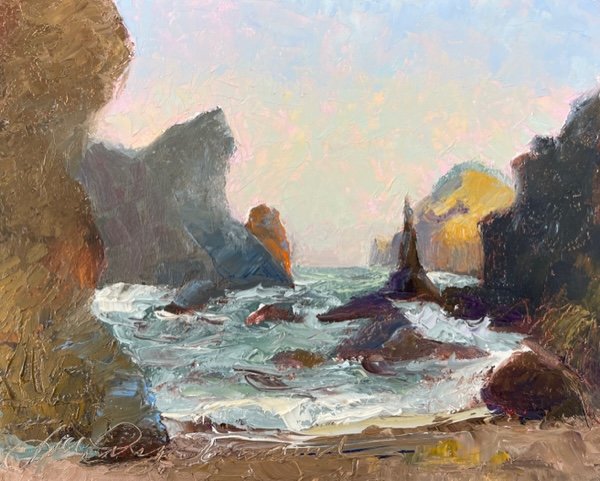
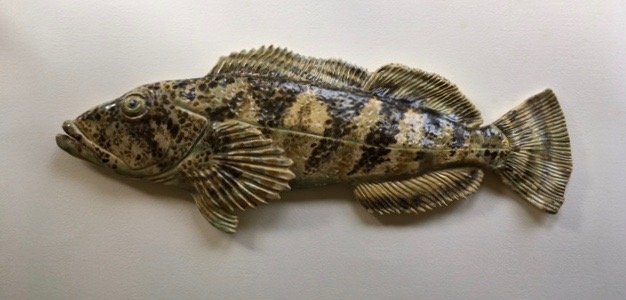
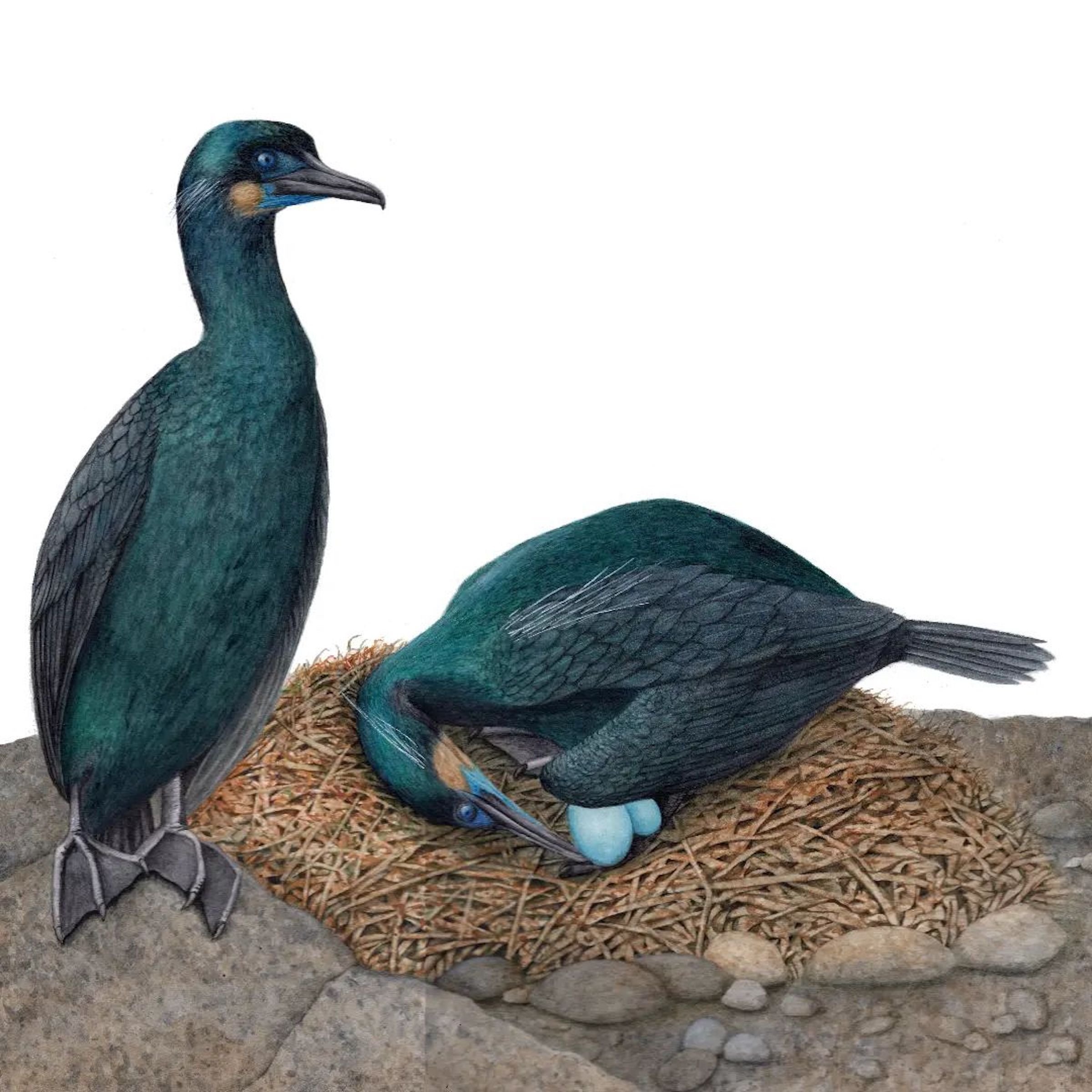

A Great Day to Celebrate Migratory Birds!
We celebrated World Migratory Bird Day (WMBD) on Saturday, May 13th, with a whole host of great activities!
We celebrated World Migratory Bird Day (WMBD) on Saturday, May 13th, with a whole host of great activities! After starting the day with a bird walk and picnic at Sitka Sedge State Natural Area, we headed back to Lincoln City for our Migratory Bird Day Festival at Oregon Coast Community College.
This year’s theme for WMBD was Water: Sustaining Bird Life, and being where we live, we know that people and wildlife alike share a deep connection to the water that surrounds us. With this theme in mind, we decided to feature the Osprey and Snowy Plover at our event, two migratory birds that rely heavily on water for survival. Luckily for us, the community college is just a short jaunt away from one of our local Osprey nests! So, after gathering at the college, we walked to Taft High School to view the nest. We were happy to see the resident Osprey pair in action, seemingly undisturbed by the group of onlookers below.
Back at the college, we had about 50 people turn up for activities including playing the “Migration Game” and making Osprey masks. Several of our community partners set up information tables, and the Peregrine Falcon and American Kestrel ambassador birds escorted by Chintimini Wildlife Center were especially big hits. People were excited to collect our “Lincoln City: Home of the Osprey” decals as well as hard copies of our map to the Osprey nests in Lincoln City.
As we moved into the evening, 21 people stayed for the presentations. Roy Lowe, retired manager of USFWS National Wildlife Refuges, did a great job of updating us on the recovering Snowy Plover populations in Lincoln and Tillamook counties. Nora Sherwood (ASLC education coordinator) and dawn villaescusa (ASLC president) talked about the Osprey of Lincoln City, sharing our new Osprey web page and story map. If you’re interested in learning more about Ospreys and their nests in Lincoln City, you can see our web page here and story map here!
Altogether, it was a great day to celebrate our beloved migratory birds! Thanks to USFWS National Wildlife Refuge System, MidCoast Watersheds Council, Friends of Otter Rock, and Chintimini Wildlife Center for making this event a success. We hope to see you for World Migratory Bird Day next year!
Osprey Awareness Initiative: Inspiring Conservation in Our Community
As far as we know, there are more Osprey nests per capita in Lincoln City than anywhere else in Oregon.
As far as we know, there are more Osprey nests per capita in Lincoln City than anywhere else in Oregon. Osprey returning each spring are noticed by residents and tourists alike, who often have limited understanding and appreciation of the bird’s migration, nesting and feeding behavior, or the importance of its coastal habitat.
With a National Audubon Society grant, ASLC is developing printed and interactive web-based maps of local Osprey nest locations. ASLC has recruited and trained volunteers to observe nest sites for initial nesting behavior and eventual rearing of chicks. Other chapter activities include Osprey-focused bird walks and featuring the Osprey on Migratory Bird Day, May 13.
Designed as a first-year pilot program, ASLC intends to repeat this initiative annually to collect ongoing community science data regarding nest occupation and fledgling success. Through these efforts, we hope to raise awareness of this distinguished Oregon State Raptor and the excitement of birding.
Help Us Help Science: Great Backyard Bird Count 2023
It’s February again, and it’s almost time for the Great Backyard Bird Count!
It’s February again, and it’s almost time for the Great Backyard Bird Count! This year’s count will be on February 17th through the 20th, and bird enthusiasts around the world will join in collecting useful data from the comfort of their own backyards.
It’s easy to participate: for as little as 15 minutes, choose a single location (like your backyard or favorite birding spot) and notice the birds around you. Write down every individual you see or hear, including their species, then submit your data online. The minimum amount of time you can spend counting is 15 minutes, but feel free to take as much time as you want over the course of the 4-day event! After all, when it comes to science, more data is always better!
The Great Backyard Bird Count is hosted by the Cornell Lab of Ornithology, National Audubon, and Birds Canada. Beginning in 1998, this event is a global community science project that has provided key data for scientists, conservationists, and researchers to better understand fluctuations in bird populations around the world. In the face of environmental challenges like climate change, birders can be a crucial resource for collecting these data and tracking how birds are responding to those challenges.
Want to get involved? All you need is a pen, paper, and a way to submit your data. Visit birdcount.org to learn the ways you can submit your count and watch the results roll in in real time. If you’re not confident in your bird identification skills, try the free Merlin Bird ID app from Cornell Lab to help identify birds and submit your results and attend this webinar on February 15th to get some expert guidance.
Join us and the global community of birders to observe, celebrate, and support the birds!
Celebrating 17 Years of ASLC!
This November, friends of ASLC including members, staff, and board gathered to celebrate ASLC’s birthday!
This November, friends of ASLC including members, staff, and board gathered to celebrate ASLC’s birthday! After 17 years, our little organization has grown from a small group of intrepid birders into a fully fledged conservation organization with impactful program areas and strong membership. We marked the occasion with a potluck dinner and fundraiser at the Lincoln City Cultural Center.
We enjoyed a wonderful array of dishes for dinner followed by a beautiful cake decorated with our very own Belted Kingfisher logo! Before eating, everyone had a chance to peruse items such as bird houses, a telescope and Manfrotto tripod, original bird art, field guides, and Audubon prints that were donated to our fundraising raffle.
The night’s program included a presentation and book signing by Portland-based author, Sarah Swanson. Her new book, Best Little Book of Birds: the Oregon Coast, features many of our favorite local birds and is a wonderful guide for beginner birders. We were thrilled to meet Sarah, learn about her book, and get our own signed copies.
Our Digital Media Coordinator, Nissa Parker, followed Sarah’s presentation with a debut of our new website! Nissa walked us through the site, showing off the new design and features that you see now.
By the end of the night, we had raised significant funds to support our conservation, education, and community science programs with our bellies full in good company! Many thanks to all who attended and contributed to the night.
Saving Our Kelp Forests
This year, the Oregon Kelp Alliance (ORKA) launched a project to cull urchins from kelp beds at five sites from Cape Lookout in Tillamook to Macklyn Cove in Brookings. This summer, ASLC got to help!
Audubon at Work
This year, the Oregon Kelp Alliance (ORKA) launched a project to cull urchins from kelp beds at five sites from Cape Lookout in Tillamook to Macklyn Cove in Brookings.
This summer, Audubon Society of Lincoln City (ASLC) partnered with ORKA, Oar Angling Dory charter, Oregon Freedivers, Astoria SCUBA, Oregon Coast Aquarium, and others to cull urchins at Cape Kiwanda in Pacific City. Our effort followed a carefully designed approach that includes before and after monitoring by Reef Check Oregon. More than 20 volunteer divers worked in shifts to smash purple urchins, giving the remaining kelp plants a chance to once again thrive. ASLC assisted in community science monitoring to assess urchin health while providing local knowledge and logistical support. We had a great day working with the divers and with local dory boat Oar Angling towards a shared goal of healthy fish habitat.
Bull kelp is an annual seaweed that thrives in cold rocky waters forming thick beds on subtidal rocks. Bull kelp forests provide critical habitat for diverse marine life, protect shores from erosion, and reduce ocean acidification through carbon sequestration. Read more (PDF)…
In 2017, Oregon divers noticed that our west coast kelp forests were rapidly disappearing. The cause: Purple sea urchins. Normally kept in check by sea stars, the urchin population exploded when our sea stars were virtually wiped out a few years ago by Sea Star Wasting disease, which was caused by warming ocean temperatures. Without predators, voracious urchins wiped out our magnificent kelp forests. Purple urchins are not bad but the ecological imbalance threatens kelp forests as well as the fishing and tourism industries dependent on them. Read more...
Our day restoring kelp at Cape Kiwanda was fun, safe, and successful. It demonstrates that community groups can work together to do something to offset the impacts of climate change. Kelp restoration at Cape Kiwanda and elsewhere along the Oregon coast will require a sustained effort. Urchin culling through a scientific approach is just one of several projects aimed at restoring kelp forests. Others include urchin ranching, replanting kelp, and reintroducing sunflower stars.
Community Science Opportunities
We have opportunities for you to help protect Oregon’s spectacular coastal wildlife!
Do you love watching the Black Oystercatchers prying mussels from exposed rocks? Are you full of joy seeing a family of tiny Snowy Plover on the beach? Do you wish you had some way to help protect these and other marvelous creatures of the Oregon Coast?
We have some opportunities for you!
You can help to protect sea and shore birds along the coast by joining one of the surveying or monitoring efforts. Training is provided by Portland Audubon staff. Follow the links below to learn more!
Oregon Black Oystercatcher Project
Black Oystercatchers are a striking and easily recognizable bird in which we share our coast. It is also a species of conservation concern because of its small population size and vulnerability to a variety of impacts.
Learn how you can help monitor oystercatchers!
Snowy Plover Patrol
Portland Audubon is partnering with Oregon Parks and Recreation Department to monitor for endangered western Snowy Plovers four sites on the North Coast (from Clatsop Spit in Astoria to Sitka Sedge beach near Pacific City) starting in April and continuing through the summer.
Learn how you can become part of a snowy plover patrol!
Seabird Nest Colony Monitoring
Do you like seabirds and care about their welfare? Join a volunteer opportunity to monitor seabird nests at Cape Falcon Marine Reserve and at Oregon’s iconic Haystack Rock.
Learn how you can help monitor Oregon’s nesting seabirds!
Marbled Murrelet Surveys
Join the annual Marbled Murrelet community science survey on a spectacular stretch of Oregon’s coast. Training will be provided, so no prior experience is needed.
The New Private Forest Accord
The new Private Forest Accord provides much-needed updates to Oregon’s Forest Practices Act. Learn more about this great step toward protecting Oregon’s forest habitats!
A Watershed moment for the Future of Oregon's Forests
Photo courtesy of Oregon Wild
Recently, industrial timber, small woodlands, and conservation representatives hammered out an agreement known as the Private Forest Accord. This is a tremendous opportunity to update and modernize Oregon’s Forest Practices Act to the benefit of all Oregonians. The agreement prepares for development of a Habitat Conservation Plan designed to protect endangered species. While the agreement does not specifically mention drinking water, the proposed no-cut buffers will improve both water quality and quantity in streams that cross private timber lands. This is a big deal for coastal communities like Lincoln City.
Background
Photo courtesy of Oregon Wild
For many years there have been deep political and social tensions over the Oregon Forest Practices Act (FPA). The FPA was one of the first in the nation in 1971. But as science and public expectations grew, neighboring states like Washington and California dramatically revamped their forest laws to better protect water quality and fish and wildlife habitat than in Oregon. Oregon evolved only incrementally. Efforts by fishing and conservation groups to advance reform through the Board of Forestry or the state legislature were consistently unsuccessful. Key federal agencies also weighed in strongly on the need for reform, and they cut off millions of dollars in grants to coastal communities because Oregon forest laws did not protect water quality. In contrast, many timber industry advocates maintained that changes were unnecessary.
In late 2019, Governor Brown convened two parties, a coalition of fishing and conservation groups and the timber industry, to seek resolution outside of the ballot box. The intensive negotiations resulted in a Memorandum of Understanding (MOU), which included a commitment to pursue mediation to seek a Habitat Conservation Plan (HCP) for private forests focusing on protecting imperiled fish. This overall approach -- agreement by the parties to set aside past conflicts and to work together to a common goal -- came to be called the Private Forest Accord (PFA).
The parties worked steadily throughout 2021, with multiple long meetings every week. The parties signed an agreement early in the morning on October 30, which the Governor announced later that morning via press release. All of the documents that were affirmed on October 30 are available here [PDF]. Ten summary documents, available on request, were prepared by the conservation and fishing negotiators to provide shorter descriptions of the issues covered in the agreement. The agreement now advances to the legislature to be codified into law; following that, a plan will be developed to present to federal fish and wildlife agencies for final approval under the Endangered Species Act.
Oregon clearcut without stream buffer
Photo courtesy of Oregon Wild
Learn more!
View this webinar to learn how the PFA will safeguard water quality, provide rural communities with greater economic certainty, and protect threatened and endangered fish through a Habitat Conservation Plan. Panel speakers were at the table throughout the negotiations. They will share how this historic agreement came to be, what it means, and what still needs to happen to make it a reality as Oregon moves forward into a new era of forest management.
Learn how forest practices in Oregon are changing for the better, and what you can do to help support this historic turning point in state management of our abundant natural resources. The hour-long webinar includes a question and answer session.
Brought to you by Lincoln City Audubon, Oregon Wild, and delivered by Oregon Coast Community College.
Photo courtesy of dawn villaescusa
Christmas Bird Count - It's for the Birds!
It’s that time of year again! Learn more about Christmas Bird Count 2021.
All skill levels and ages are welcome...don't fret if you are a beginning birder as this is a perfect opportunity to learn more about our local birds while participating in this free citizen science event. During the Christmas Bird Count volunteers tally as many species and number of individual birds as they can from sunup to sundown.
Considered the longest running Citizen Science survey in the world and led by the National Audubon Society, Christmas Bird Count data provides critical data on bird population trends. We are fortunate to boast three count circles in our area: Tillamook Bay CBC, Lincoln City CBC, and Yaquina Bay CBC.
Tillamook Bay CBC
Saturday, December 18th
The Tillamook Bay CBC is one of the oldest counts in the State. Last year, having to cancel due to Covid guidelines, interrupted a 56 consecutive year streak. The count circle stretches from Netarts north to Rockaway Beach and east to include the Kilchis and much more (see map). If you love bird watching in this rich coastal habitat, contact us! You will be assigned to a team of field counters with a specific area to cover. All experience levels are welcome!
Field counters need to dress for Oregon coast weather. Mud boots or sturdy shoes are recommended. Bring your own optical equipment. You will also want to bring a lunch or something to snack on throughout the day, plus plenty of water. (Most sector leaders do not stop for lunch.)
If that sounds too strenuous, or you just don't have the full day to spend, you can participate as a backyard/feeder counter if you live in the Tillamook bay area.
WANT TO HELP?
Participation is FREE, but you do need to pre-register. Please contact Kathy Krall at krallfamily@comcast.net to be put on a team or to receive instructions on backyard counting. This count is sponsored by the Audubon Society of Lincoln City.
Lincoln City CBC
Sunday, December 19th
The Lincoln City count circle, like all others, is 15 miles in diameter. We've divided ours into seven sectors (see map). This is a relatively new count, less than ten years old. Our circle covers lakes, forests, streams, meadows, and ocean.
Field counters need to dress for Oregon coast weather. Mud boots or sturdy shoes are recommended. Bring your own optical equipment. You will also want to bring a lunch or something to snack on throughout the day, plus plenty of water. (Most sector leaders do not stop for lunch.)
If that sounds too strenuous, or you just don't have the full day to spend, you can participate as a backyard/feeder counter if you live in the Lincoln City area (see map). We will provide a checklist and guidelines.
WANT TO HELP?
Participation is FREE, but you do need to pre-register. Contact us at aslc@lincolncityaudubon.org to be put on a team or to receive instructions on backyard counting. This count is sponsored by the Audubon Society of Lincoln City.
Yaquina Bay CBC
Wednesday, December 29th
The 49th Annual Yaquina Bay Christmas Bird Count covers a diverse area from Newport to Toledo and south to Seal Rock (see map). We need your help to serve on a field team or to conduct a feeder count.
WANT TO HELP?
Participation is FREE, but you do need to pre-register. Contact CBC coordinators Kai Frueh at Kaifrueh2@gmail.com or Hendrik & Oscar at hhactitis@gmail.com.
Christmas Bird Count - Frequently Asked Questions
What is a Christmas Bird Count (CBC)?
It is an early-winter bird census, where thousands of volunteers across many countries in the Western Hemisphere count birds over a 24-hour period on one calendar day.
What is a Count Circle?
It is a designated 15-mile (24-km) diameter circle in which birds are surveyed each year on count day.
Where can I count?
If your home is within the boundaries of one of the count circles (see map), you can stay at home and report the birds at your feeders, in your yard, or flying overhead on count day. If you want to join a team in the field, you need to register with the CBC coordinators using the contact information provided on ourcalendarpage.
When can I count?
Any time from midnight to midnight on the date of the count in your area.
What equipment or tools do I need?
A pair of binoculars, a checklist of local birds, and a good bird book. Sibley Field Guide to Birds of Western North America is one example. In Lincoln City, a simple checklist will be emailed to you prior to count day.
How do I report?
It’s easy! If you are counting in your backyard, we will provide you with a simple checklist that you can fill out and email to the CBC coordinator listing each species (e.g., Chestnut-backed Chickadee), how many you saw and your time (see “My count” and “My time” below). If you are with a team in the field, your team lead will have a checklist for the team.
My count:
Look for the maximum number of each species visible (or within earshot) at any one time. For instance, if you see 5 chickadees on your feeder at once, and a few minutes later a single chickadee flies by after the 5 are gone, don’t add another to your count.
My time:
Report how long you spend counting birds. If you count on-and-off during the day, keep a tally of time spent so you have an accurate total at the end of the day.

